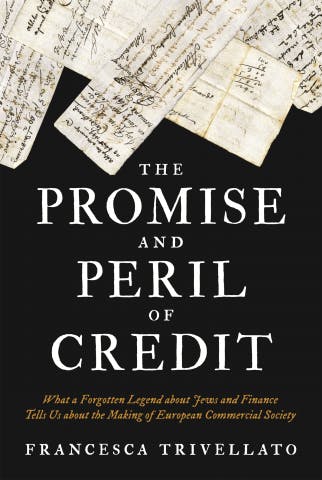Even
at the beginning of the twenty-first century, the old anti-Semitic specter of the
Jew as a financial international manipulator and money-grubber persists, from
Moscow and Budapest to Des Moines, Iowa. Hungary’s neo-authoritarian leader,
Viktor Orbán prospers politically by portraying the financier George Soros and
Jews in general as shadowy, “ungenerous” figures who fight “by stealth,” who
are not “honorable, but unprincipled; they are not national, but international;
they do not believe in work, but speculate with money; they have no homeland,
but feel that the whole world is theirs.” In October 2018, Chuck Grassley told
Fox News that he believed Soros uses his “billions” to secretly manipulate
politics.

As Francesca Trivellato shows in her extraordinary book, The Promise and Peril of Credit: What a Forgotten Legend about Jews and Finance Tells Us about the Making of European Commercial Society, the bigoted cliché of the Jew as a representative of shady international financial deals has a long and error-filled history. For centuries, Jews have been falsely credited with the invention of bills of exchange, which are considered essential to the origins of capitalism, but which also were mistrusted as a form of financial trickery. Trivellato has discovered that this fundamental anti-Semitic story has its roots in a long-forgotten, seventeenth-century French legend about Jews and usury.
Trivellato’s discovery is based on her earlier work on how Jews, and indeed, other diasporic groups like Armenians, gained financial prominence and expertise through trading within their international networks from the middle ages into the modern age. But capitalism and finance were not Jewish inventions. They came from medieval Italy with the rise of multi-partner firms, where double-entry bookkeeping emerged around 1299. They also grew out of the credit markets based on bills of exchange (bill comes from “bulla,” in Italian, means letter), which had existed in one form or another since antiquity, but now became essential for international, capitalist trade.
Trivellato’s main point here is that European Jews did not get their start in finance through usury or bills of exchange. To invest such great sums and to have the privilege to make such returns on them, even skirting canon law, was a practice deemed too lucrative and important to accord to non-Christians. This was a Christian privilege. Hence, medieval and Renaissance banking in Europe was tightly intertwined with Christianity. The oldest bank in Europe, the Banca di Monte dei Paschi si Siena, founded in 1472, means the “Bank of the Holy Mount.”
Bills
of exchange were complex instruments for moving and exchanging money via paper
slips rather than sacks of minted coin. While they were not really a form of
paper money, they were paper transactions that allowed bankers to move money,
often internationally, using only promissory notes.
In the late 1300s and 1400s, bankers, such as Cosimo de’ Medici, who used bills of exchange and understood the general ebb and flow of the exchange rate, could make regular returns of 2 to 16 percent, with small losses now and then, but mostly, staggering fortunes. This meant that many rightfully saw the bill of exchange as a means of taking bank deposits—the pope placed his money with the Medici—and investing it for returns, or interest, which was usurious and illegal according to canon law. To get around the law, Italian bankers renamed the interest paid to their depositors discrezioni, or discretions, not made contractually, but as gifts, and thus not usury.
Trivellato explains that not only did this hat trick appear dishonest (which it was—the discrezione was interest), but that the bills themselves were covered with hard-to-decipher terms and conditions. The average person could not understand the coded financial language of the bill, making it seem both sinful and mysterious. Although bills of exchange were not proper currency, backed by a prince or a state power, merchants guaranteed their value and used them to make transactions without metal currency, which, in the minds of people only familiar with minted coins as money, also made the bill seem like a sleight-of-hand. Merchants could be seen writing the values of the bills as promissory notes in their account books.
All
the while, rural and noble Europe, already suspicious and disdainful of the
merchant class, frowned upon the mysterious credit mechanics of bills of
exchange. It was not in Italy, but in seventeenth-century France, as Trivellato
shows, that the legend of the Jew as the inventor of the bill of exchange
emerged in a long-forgotten, but once influential book of the merchant arts:
Jean Cleirac’s 1647 handbook Usages and
Customs of the Sea. The violent French Wars of Religion that pitted
Catholics against Protestants in the last decades of the sixteenth century laid
waste to much of France’s urban commercial culture and threatened to destroy the
ancient kingdom. Thus, in an attempt to boost commercial activity, the French
monarchy decided to invite Dutch “Portuguese merchants” to the port city of Bordeaux.
The arrival of these New Christian, or crypto-Jews, who had fled Iberia after
the Inquisition and their official expulsion in 1536, was considered contrary to
Christian dominance; these “false Christian” traders from another land were
seen as shady financiers, whose money came from overseas, and who, by their
very ambiguous foreign nature, came to be associated with the untrustworthy and
unholy bills of exchange.
Cleirac’s handbook on seafaring trade covered the rules, regulations, paperwork, customs, ports of call, and currencies necessary to be a successful trader. It focused on the complexities of marine insurance and bills of exchange. And with no historical grounding, it claims that Jews, “these abominable uncircumcised” who had been “banned from France” in the twelfth century “because of their wrongdoings and inexecrable crimes,” had created bills of exchange and marine insurance to hide their perfidious dealings. He claimed that only after the expulsion of the Jews did Italian merchants take over this vile finance that put “Christianity through great troubles and tumult.” Trivellato meticulously shows that there was and is no historic basis for Cleirac’s claim other than the local prejudices and beliefs of seventeenth-century Bordeaux. The new “manifest usurers” threatened the established order and the faith in the Bordelais Christian merchants. Now, outsiders could believe that any one of them could be a hidden, “predatory” Jew.
Though forgotten today, Cleirac’s book was influential in its time. Trivellato has found that a version of his legend of the Jewish invention of bills of exchange made its way into Jacques Savary’s famous 1675 merchant manual, The Perfect Merchant, which he wrote with the backing of Louis XIV’s famed minister, Jean-Baptiste Colbert. Savary repeated his own version of Cleirac’s legend that bills of exchange “came from the Jews who were chased out of France” in the middle ages. Here was the legend repeated in what was to become the single most influential European commercial manual of the late seventeenth and eighteenth centuries, and one of the most important books in the history of commerce. The book went through multiple editions and was translated and circulated across Europe. Trivellato speculates that Jews threatened Savary’s vision of the merchant as a man of honor.
His sons reedited the work as Universal Dictionary of Commerce in 1723. The Savary brothers not only perpetuated the legend; they associated Jews with Amsterdam, a constant threat to French trade, and reiterated that “Jews have the reputation of being very skilled at commerce but they are also suspected of trading without the maximum of honesty and probity.” They noted several examples of when a merchant is dishonest, they are acting like a Jew. They thus expanded the legend into a stereotype, and it went out as writ for merchants across Europe who already believed that Jews were the murderers of Christ and drank the blood of Christian children. Most disturbingly, Trivellato shows how modern economic historians and economists—from Werner Sombart to Max Weber—adopted elements of the legend too, in spite of the clear historical evidence to the contrary.
The question that the book leaves unanswered is how the medieval blood-libel anti-Semitism and this financial anti-Semitism fused in the powerful brew that became modern anti-Semitism. One can imagine that it happened within various Churches, Catholic and Reformed, that saw usury as evil and Jews as Christ-killers. That wider story still needs to be told so that we can understand how the anxieties of the Christian, commercial world turned into an irrational belief so deep that it still dominates political discourse and social mores. Most surprising of all is that it took this long for a historian to tackle this legend and trace its origins. Trivellato’s excellent book shows the power and the necessity of credible history to fight ever corrosive and dangerous legends alive and thriving in our own technologically-advanced yet troubled times.
